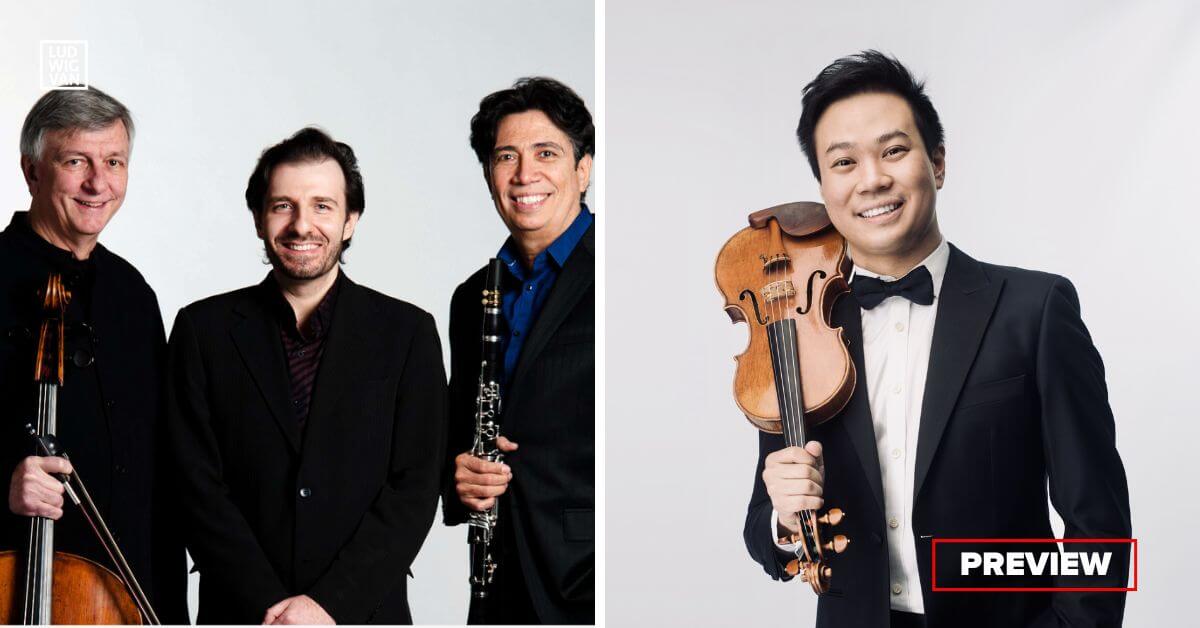
The folkloric rhythms and melodies of Eastern Europe are the inspiration for Transylvanian Express, a concert by the Amici Chamber Ensemble. The performance takes place on February 25.
The Amici Chamber Ensemble is Joaquin Valdepeñas, clarinet, David Hetherington, cello, and Serouj Kradjian, piano, and they fill a unique niche in Toronto’s chamber music matrix. They’ll be joined by award-winning violinist Nikki Chooi in an imaginative and entertaining program.
Nikki Chooi, violin
The guest soloist for the evening will be Nikki Chooi, violinist and concertmaster of the Buffalo Philharmonic.
American-Canadian violinist Nikki Chooi is a Laureate of the Queen Elizabeth and Tchaikovsky Competitions, and earned 1st Prize at the Montreal Symphony’s ManuLife Competition, the Klein International Strings Competition, and the Michael Hill International Violin Competition. He made his Carnegie Hall debut in the 2022-23 season, and was a featured soloist with the Vancouver Symphony, National Taiwan Symphony Festival Orchestra, Santa Fe Symphony, Hamilton Philharmonic, and Manitoba Chamber Orchestra last season alone.
Nikki’s discography includes recordings on the Naxos, Beau Fleuve, Atoll, and Decca labels. He performs on two historic instruments: a 1713 Stradivarius courtesy of CANIMEX INC. from Drummondville, Quebec, Canada, and a 1749 G.B Guadagnini on extended loan through the Stradivari Society of Chicago.
The Program
The program is inspired by the music of Eastern Europe, from Bohemia to those who were inspired by a bohemian lifestyle.
Franz Liszt: Hungarian Rhapsody
Franz Liszt was often influenced by the Hungarian folk music of his homeland, and incorporated its unique rhythms and harmonies into his compositions. He wrote 19 Hungarian Rhapsodies in all, of which No 2 in C-sharp minor is the most famous. The theme can be found in one of Liszt’s Weimar sketchbooks, a notation he made after hearing it played by the Austrian pianist Heinrich Ehrlich.
Vittorio Monti: Csárdás
Italian composer Vittorio Monti wrote Csárdás in 1904, based on the Hungarian folkloric piece of the same name. The original instrumentation included piano, violin, and mandolin. The rhapsodic piece has seven sections, and a great emotional and dynamic range.
Zoltán Kodály: Duo for Violin and Cello, Op. 7
Noted for its lyricism, Zoltán Kodály’s Duo for Violin and Cello, Op. 7 was written in 1914. Like Bartók, Kodály considered exploring Hungarian folk music an integral part of his musical practice. He researched the genre, and his compositions are often rooted in that well of inspiration. Opus 7 is an example of how he was able to interweave the elements of Hungarian folk music into the structures of art music.
Max Bruch: Three Pieces for Clarinet, Cello, and Piano, Op. 83
Bruch’s son Max Felix taught music theory at the Hamburg Conservatory. He was also a talented clarinettist, and late in life, Max senior wrote two pieces for him, of which Opus 83 is one. He preferred to accompany the clarinet with viola, as he did in his seldom performed Concerto for Clarinet, Viola and Orchestra, Op. 88, or as here, with a cello, rather than a violin. In the style of the time, they were characterized as character, or thematic pieces
Béla Bartók: Contrasts for Violin, Clarinet and Piano, Sz. 111
Until this commission, Bartók had never used a wind instrument in a chamber work before, unlike many of his contemporaries. Béla Bartók wrote Contrasts in 1938, basing it on Hungarian and Romanian folk dances. The piece was commissioned by American clarinetist Benny Goodman, although the initial spark came from a letter to Bartók from violinist Joseph Szigeti. The piece features the composer’s characteristic polymodality, and the three movements contrast each other in tempo.
- Find tickets and more information about the concert [HERE].
Are you looking to promote an event? Have a news tip? Need to know the best events happening this weekend? Send us a note.
#LUDWIGVAN
Get the daily arts news straight to your inbox.
Sign up for the Ludwig Van Toronto e-Blast! — local classical music and opera news straight to your inbox HERE.
- PREVIEW | SUMMER OPERA LYRIC THEATRE Presents Handel’s Xerxes, Mozart’s Idomeneo & Puccini’a La Boheme July 26 To August 4 - July 26, 2024
- PREVIEW | YENSA Festival V.2 Offers Black Flames Performances & Other Ways To Celebrate Black Women In Dance - July 25, 2024
- PREVIEW | Canadian Talent Conspicuous In The Met: Live In HD 2024-25 Season - July 25, 2024



